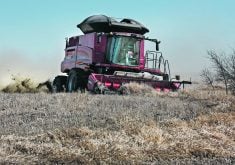ROULEAU, Sask. – Gordon Stephenson, executive director of the Western Beef Development Centre in Saskatoon, was one of the producers involved in the first round of testing radio frequency ear tags.
He agreed to test the electronic tags for their retention rates and suitability versus regular tags.
“We inserted them into 292 calves, both heifers and steers, at turnout time, around June 15, 2002,” Stephenson said.
“Our observation is the retention rate on the tags is similar to conventional ear tags. The question now is, can producers use readers and use that information to improve production or economic factors with their herd?”
Read Also

VIDEO: Green Lightning and Nytro Ag win sustainability innovation award
Nytro Ag Corp and Green Lightning recieved an innovation award at Ag in Motion 2025 for the Green Lightning Nitrogen Machine, which converts atmospheric nitrogen into a plant-usable form.
The calves involved in the test are at the University of Saskatchewan Termuende research farm near Lanigan, Sask.
“These calves all go to the Poundmaker feedlot and they’re going to monitor things like average daily gain. Then the final evaluation will be done at the packing plant, because the packing plants are indicating now that the only tags they will provide carcass data on are those animals that have electronic tags,” Stephenson said.
“We’ll see what the retention of these tags has been, once they reach the slaughter floor, and also how the packing plant is able to pick up the signal from these tags.”
When the finished calves go to the packer, Stephenson said he’ll let it know they’re coming. The packers will attempt to provide carcass data based on reading the tag numbers.
“That will give us an idea of how complicated and what the logistics are like of doing that at the packing plant.”
Stephenson said if packing plants say they’ll only provide carcass information if electronic tags are used, that will drive the process.
While it’s fine to have an electronic tag, it won’t be valuable to the producer unless he also has a reader.
Stephenson said the readers have been the biggest glitch.
“I was under the impression when we started that the information was in the tag. But the only thing inside the tag is an electronic apparatus that gives off a signal that corresponds to a number. It’s your reader that contains the information you want.
“The important part is how good the readers work. Secondly, how do you download the information from your reader, either onto your computer or some way that a producer can use it to keep track of management information on that particular animal.”
He also said there needs to be a tie-in between the electronic tag and the Canadian Cattle Identification Agency number so there aren’t separate trace-back, management and electronic tags.
“Hopefully, sometime in the future, producers can have a management tag and this electronic tag will also be their CFIA animal ID tag.”
Stephenson said if a producer doesn’t have a computer program and doesn’t want to use a reader, he can still use an electronic tag for management if it has a dangle portion. It can carry the CCIA number and be used to link carcass data to the animal when it goes to the packing plant.
“One of the barriers is the price of the tags. Producers can buy a management tag for under $1, so if the cost of these is $2 or more, that could be a barrier.
“And producers say they should be sharing the cost of these tags with other users up the value chain. If the calves go to a feedlot that gathers production data off these animals, they can make use of the electronic tags as well.”
















